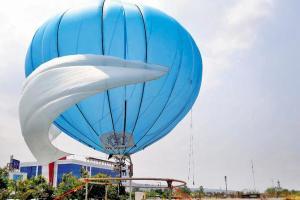A Mumbai aerospace engineer talks about creating a Wi-Fi balloon for Uttarakhand villages and why it can pose serious competition to drones

Mumbai-based aerospace engineer Vishaal Sharma's balloon-mounted internet network will bring free WiFi to the state's most remote areas. According to Sharma, it can be utilised in controlling crowds and disaster management too
Earlier this month when Uttarakhand chief minister Trivendra Singh Rawat unveiled the country's first ever balloon-mounted internet network that would bring free Wi-Fi to the state's most remote areas, Mumbai-based aerospace engineer Vishal Sharma found himself on cloud nine. After all, it was his baby. For the last seven months, Sharma from IIT Bombay had worked on this pilot project under the guidance of professor Rajkumar Pant to create an aerostat balloon system. The objective being to help facilitate relief and rescue operations in remote areas, besides bringing connectivity.
ADVERTISEMENT
A floating technology
Sharma, 29, who resides at the IIT Bombay campus itself, says the idea behind the balloon-based internet germinated back in 2003 when an experiment was conducted at their lab to provide internet connectivity to rural areas. The research material was then published in several international journals. Fifteen years later, the Uttarakhand government decided to put this technology to action. "These days a lot of migration is taking place in hilly areas. People are moving to towns and cities because they don't have mobile connectivity and other digital resources. It is a major concern for the government right now," Sharma, explaining how they landed the project.
The mechanism is simple. You fill lighter-than-air gas such as helium and hydrogen inside the envelope, enabling the balloon start floating in the air. The aerostat system is then fitted with cameras for surveillance, a base transceiver antenna to make calls and a Wi-Fi modem to provide internet. "We also have ground equipment that connects the balloon to the ground station — which is how we can control and the ascent and descent of the system," he explains. The balloon is designed to go up to 200 metres above ground. Since the radio frequency signals depend on the height and area, Sharma says they have decided to mount this on a vehicle and take it wherever.

Vishaal Sharma
Controlling crowds
According to Sharma, its use goes well beyond internet connectivity and can be utilised in controlling crowds and disaster management. "What typically happens during a disaster is the disruption of the mobile towers, which leads to chaos because people can't connect to rescue teams ," he says. While special forces have their own antennas so that they communicate with each other, it's not the case with civilians, he adds. But this technology, he believes will help bridge the gap. "We can put different sensors and high definition camera and float it on an altitude for live monitoring," he says. Another important use of this technology is in the area of environment. "Since it is fit with sensors, it can collect air samples from different areas. So if there's a gas leakage it can collect and transfer it to the system,"
he says.
While the technology may not be common, Sharma says there are companies across the country working on its implementation. For instance, Aerial Delivery Research and Development Establishment in Agra is developing a 70 metre-long balloon for border security and surveillance. The one created by his team is 6m x 3.5m in size and is capable of holding 35 kg. The balloon has been created using fabric that is tear resistant. While the outer layer is made with a special quality nylon, the inside is lined with low-density polyethylene (LLDPE), a thermoplastic made from the monomer ethylene. The team is currently working on different fabrics to find the right fit. According to Sharma, unlike a drone that cannot fly more than 30 to 40 minutes, the balloon can stay afloat for 21 days. It also does not need to be manned constantly.
However, for the aerostat to operate efficiently it requires an open space, relatively clear of buildings. "It should not collide with any structure. Also, it is susceptible to very strong winds," he says. It can withstand light rains and sustain wind speed of 35 kmph. If wind speeds exceeds this, the balloon has to be hauled back to ground.
Bringing positive change
Sharma believes the balloon can help take the PM's digital dream to areas that right now don't even feature on the radar. While the current cost of the project is pegged around R50 lakh, with further development and mass production, the costs could reduce. Sharma says this can also be installed in the city. All one needs is a small ground with 30 metres of clear area. "In fact, there's a company in Brazil formed by students that has deployed it in urban areas. They did it for the Olympics."
50 lakh
The current cost of the project is pegged around
Catch up on all the latest Mumbai news, crime news, current affairs, and also a complete guide on Mumbai from food to things to do and events across the city here. Also download the new mid-day Android and iOS apps to get latest updates
 Subscribe today by clicking the link and stay updated with the latest news!" Click here!
Subscribe today by clicking the link and stay updated with the latest news!" Click here!






